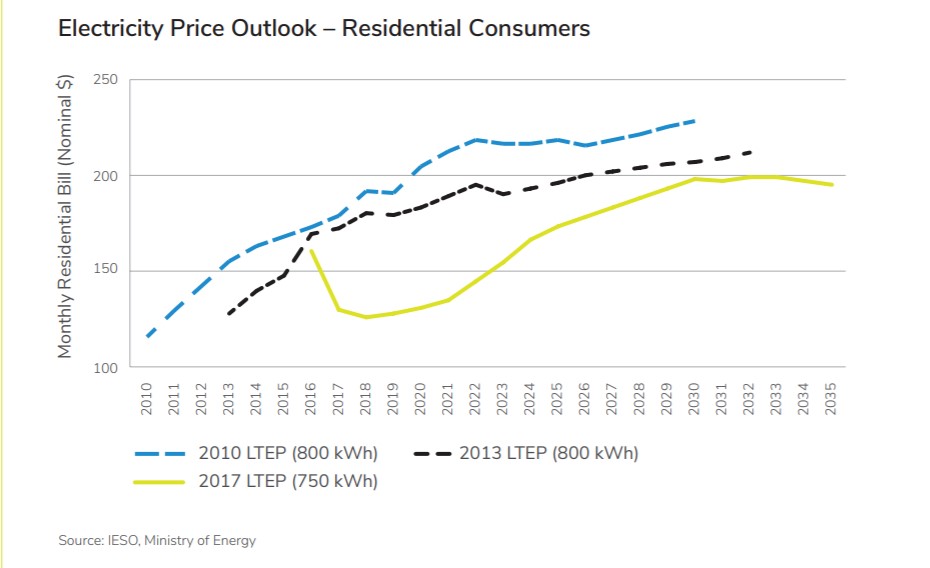Can the Ontario Government Reduce Hydro Rates?

The StrategyCorp Institute of Public Policy and Economy will be producing a series of articles to explore the Ontario government’s options to achieve their stated electricity goals, including the promised 12% electricity savings for residential customers. Part two will examine how to measure the 12% and what it means for the electricity system.
On November 1, 2019 hydro rates went up by inflation as predicted under the Fair Hydro Plan, which is the previous government’s four-year financial subsidy that reduced rates overnight by a cumulative total of 25%. In real terms, the November 1, 2019 rate increase amounted to $1.99 or 1.8% per month. Even though the increase itself does not even amount to a case of beer over an entire year, it is still an increase in hydro prices instead of the promised 12% decrease. In order to keep the 12% rate reduction promise, the Ontario government will need to make some bold decisions. Before they can do that, the government will need to be clear on what exactly 12% means. We set out to answer that question.
How do We Measure the 12%?
Our last energy piece revealed the changes coming to Ontario hydro bills that the government has since implemented. The first option to achieve the 12% reduction was convincing people their bills were already reduced. This new policy would clearly show the full amount government is saving ratepayers on a monthly basis, through a new line-item called the “Ontario Electricity Rebate”. That approach serves two purposes: it shows people the raw cost of electricity, and it encourages people to give some credit to the government for the billions they are currently spending on rate reductions. Unless ratepayers think those savings are new, the government will still be tasked with achieving its 12% reduction.
To achieve the 12% promise, the government will need to set a benchmark for exactly what the 12% is measured against. First, the government must successfully argue that the 12% should be applied against the average hydro bill after the Fair Hydro Plan is incorporated. If the government were to attempt to reduce the pre-Fair Hydro Plan cost of electricity by 12% the cost would be simply enormous. This argument should be widely accepted as the savings promise made in both Ontario PC party platforms was done after the Fair Hydro Plan was implemented by the previous government.
Next, it must be noted that the 12% is made up of many incremental decisions – not a single subsidy. Unlike when the Fair Hydro Plan came into effect, there will be no sudden overnight drop in rates. Therefore, the government must plot its reduction against a realistic projection of hydro bills in order to show ratepayers that bills have been reduced. That projection should likely be the 2017 Long Term Energy Plan (LTEP) put forward by the previous government.


The last Ontario Energy Board scheduled bill adjustment before the June 2022 election will be on May 1st, 2022. Under the old LTEP, the Fair Hydro Plan subsidy would expire in 2022 and bills would begin to rise on May 1 of that year. Politically, it would be extremely dangerous to allow bills to escalate by as much as 8% right before the election when you were elected on a mandate to reduce bills by 12%. Therefore, we assume the government will want the 12% reduction to be applicable when the May 1st, 2022 adjustment occurs, which means extending the Fair Hydro Plan out even further.
The Ford government already announced in March that they will hold bill increases to inflation, enabled by bringing the Fair Hydro Plan onto the books and using a lower government borrowing rate. However, the government did not specify when this inflationary-increase-only policy would expire. Due to the timing of the 2022 election, one can assume that policy will continue to cover the first scheduled bill increase in May of that year even though the original Fair Hydro Plan was set to expire before then. Therefore, we need to look at the province’s inflation projections, which come from the 2019 Fall Economic Statement (p 7) and are captured below, to get a sense of what kind of impact such a decision would have:
 Ontario’s predicted inflation over the next few years is 2% or less. When that is compared to the projected bill increases under the 2017 LTEP, the government would see a sizable reduction in future bills just from using the refinancing scheme to hold bills at inflation:
Ontario’s predicted inflation over the next few years is 2% or less. When that is compared to the projected bill increases under the 2017 LTEP, the government would see a sizable reduction in future bills just from using the refinancing scheme to hold bills at inflation:

The table above reveals a few interesting facts. First, the total difference between inflation and the 2017 LTEP before factoring in any compounding benefit will be at least a 7%. Essentially, the government can prove at least 7% of the 12% reduction has been achieved just by accounting for the Fair Hydro Plan differently and extending it for a few more months than the previous government.
By counting the inflationary only increases as part of the 12% reduction, the government will be able to achieve a substantial amount of its goal through its already existing Fair Hydro Plan subsidy program. However, there are consequences to this decision.
What Does it All Mean?
Financial Impact:
This is not simply fun with numbers or shuffling the deck chairs. There are very real financial consequences to extending the Fair Hydro Plan to 2022 and holding rates to inflation. In 2019-20 alone the cost of the Fair Hydro Plan subsidy will be roughly $4 billion (p 169).
If the government is planning on continuing the Fair Hydro Plan program out to 2022, there will be a very real impact on its books but a much better chance at achieving the 12% savings target. If the government plans on letting the Fair Hydro Plan subsidy expire before 2022, the costs to the treasury will be reduced drastically but hydro bills will escalate by as much as the $10 a month predicted in the Liberal LTEP and the 12% savings will be much tougher to achieve.
Communications Challenge:
Apart from the fiscal challenge, communicating the lack of an increase in bills as savings will be difficult. Ontarians will not be able to compare their month-to-month bills and see a 12% overnight drop. Rather, the change will be compared to what their bill would have been under the Liberal government. The government should be able to take credit for cost avoidance instead of material savings, but Ontarians may not see it the same way.
Impact to Ontario’s Energy System:
There are two main takeaways from this benchmarking exercise for the electricity system. First is that the government can easily subsidize its way to the 12% reduction if it wants. However, believing that the government is willing to do that would be naïve. Policy changes that reduce the cost of electricity and lead to actual savings felt by customers are certainly preferred. Structural savings would reduce the need to subsidize bills – saving the treasury money – and last well past the assumed 2022 expiry of the Fair Hydro Plan.
The second key takeaway is that there is still a serious and real threat of skyrocketing hydro bills in Ontario in the very near future. When the Fair Hydro Plan expires, be it in 2022 or otherwise, bills will begin to increase well past the rate of inflation – as predicted in the 2017 LTEP. Therefore, the government will inevitably face a hydro crisis again, even if it occurs after the next election.
For stakeholders in the energy space, this should all mean that the government does in fact have a path to the 12% reduction. However, it should also mean that band-aid subsidies and one-time payouts are not a long-term solution. The desire from the government to find lasting savings through other ideas – including capping profits for private sector players, renegotiating generation contracts, or limiting a distributors rate of return – are very much alive and well. Stakeholders should be prepared for tough conversations with government even if they do not focus on the immediate 12% reduction.
Conclusion
By keeping electricity increases to inflation and measuring bills against the former governments LTEP, the Ford administration should be able to get a significant amount of the way towards their 12% reduction target without many meaningful system changes. However, portraying a lack of an increase as a savings will be a communications challenge and will come with a significant cost to the provincial treasury.
To make matters worse, electricity prices will spike as soon as the Fair Hydro Plan’s $4 billion a year subsidy expires. Though the government can extend that subsidy until after the 2022 election, the province will be faced with skyrocketing bills once again. Therefore, sitting on their hands is not an option for this government. Any policy ideas that lead to actual savings and a cheaper cost of power will be preferred instead of continuing billion-dollar subsidy programs indefinitely. The clock to 2022 is ticking, and the government is running out of time to find and implement those ideas.
Part three of the StrategyCorp series on electricity will explore additional savings ideas the government can use to achieve its 12% promise or reduce the amount of money it spends subsidizing bills.
[1] (a) Only publicly available data is used, which may be outdated; (b) The 2017 LTEP assumed the average household used 750 kilowatt hours of power a month, but the Ontario Energy Board has since restated that calculation to 700 kilowatt hours a month, thereby reducing the cost of the average bill; and, (c) Assumptions on the date of the 12% reduction need to be made and the government may not extend the Fair Hydro Plan out to 2022 as assumed.